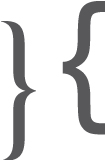
When we can't see or hear each other, it is often hard to be clear about what we are trying to say, and hard to interpret what someone else is trying to express.
Communicating with clarity is the challenge imposed with text-based forms of dialogs, and this becomes more and more important as a greater number of our personal and professional exchanges are transacted via text-based methods of delivery.
Adding a few new punctuation marks to our written communications could help correct this situation. That's what this is all about.
Unlike previous efforts that might have been purely hypothetical, needed special downloads and installations, wanted to you to PAY, or required you to remember special key sequences — we can use marks that are right there, right in front of us, right now. They are clearly visible on any standard English-language QWERTY keyboard, and a quick tap away on tablet and mobile devices.
We don't need new marks, we need to give old marks new meaning. The @ symbol has been around since 1536 and had nothing to do with email or Twitter for most of that time. Speaking of Twitter, the octothorpe a.k.a. pound sign a.k.a. number sign and now better known to millions as the hashtag, can trace its origins as far back as the 14th century, #amazing!
The asterisk is a profoundly under used mark, and is commonly regarded as ‘that mark that means read the fine print’, and that fine print is usually a qualifier/disclaimer that makes the original statement or claim somewhat less appealing. Sarcasm is a bit like that too, it sounds like one thing, but is really something else. The asterisk can be added after all our original punctuations, as well as the new ones – allowing expressive ‘voice’ but making it clear about the true intent of the statement.
examples:
Well, that will be great.* (droll, deadpan)
That’s just what I need!* (agitated)
You must be so excited))* (shared joke)
Could he be more helpful?* (sarcasm rolled into a rhetorical question)
I have no idea?~* (feigned confusion)
The tilde is rarely seen in typical text-based exchanges—with the exception of acting as a smaller element of certain emoticon configurations. The wavering configuration aligns with the uncertainty that accompanies confusion. Pairing this glyph with the question mark makes it clear that statements accompanied by this punctuation are not literal questions. This in turn clarifies statements that use an unaccompanied question mark as inquiries that anticipate a response.
The antidote to the exclamation mark epidemic. Inspired equally by the elongated form of the exclamation mark, and the familiar smile emoticon, this configuration creates a unique punctuation that is emancipated from both. The exclamation point can be reserved for circumstance that demand the heightened tone of excitement or urgency that the ! was originally intended to convey.